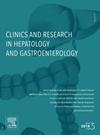Use of Hepatoscope 2DTE for non-invasive assessment of liver stiffness among Mexican immigrant adults in a community-based setting
IF 2.4
4区 医学
Q2 GASTROENTEROLOGY & HEPATOLOGY
Clinics and research in hepatology and gastroenterology
Pub Date : 2025-03-26
DOI:10.1016/j.clinre.2025.102581
引用次数: 0
Abstract
Purpose
Mexican-origin adults have one of the highest rates of metabolic dysfunction-associated steatotic liver disease (MASLD) and its severe form metabolic dysfunction steatohepatitis (MASH) in the US. Given the costs and invasiveness of liver biopsy, this study assessed the application of Hepatoscope® 2DTE, the latest-generation transient elastography for liver stiffness in Mexican adult immigrants from Southern Arizona and compared it with FibroScan® VCTE™.
Methods
Participants (n = 199) from a cross-sectional community-based study completed anthropometric measures, demographic information, a blood draw, and liver stiffness measurements (LSM) with FibroScan VCTE and the ultraportable Hepatoscope 2DTE. LSM2DTE and LSMVCTE were compared using Spearman's correlation and Bland-Altman analysis. The number of at-risk for fibrosis participants as assessed using each system was compared according to FIB-4.
Results
A total of 122 participants were considered for this sub-analysis which consisted of 71.3 % women. Mean age was 51.9 ± 12.1 years, BMI was 30.7 ± 5.7 kg/m², 43.4 % of participants had obesity, and 19.7 % were diabetic. Mean FIB-4 was 1.00 ± 0.53, and median LSM were 5.6 [4.7 - 6.7] and 5.3 [4.1 - 5.8] kPa for 2DTE and VCTE, respectively. 2DTE significantly correlated with VCTE (r = 0.53, p < 0.0001) and there was no systematic bias between the two LSM. There was no difference in the number of at-risk for fibrosis participants between the two LSM per FIB-4 categories.
Conclusion
Hepatoscope can be used for point-of-care liver stiffness assessment and risk stratification of adults at risk of liver fibrosis in community-based settings.
在社区环境中使用 Hepatoscope 2DTE 对墨西哥成年移民的肝脏硬度进行无创评估。
目的:墨西哥裔成年人是美国代谢功能障碍相关脂肪性肝病(MASLD)及其严重形式代谢功能障碍脂肪性肝炎(MASH)发病率最高的人群之一。考虑到肝活检的成本和侵入性,本研究评估了Hepatoscope®2DTE的应用,这是最新一代用于检测亚利桑那州南部墨西哥成年移民肝脏硬度的瞬时弹性成像技术,并将其与FibroScan®VCTE™进行了比较。方法:来自横断面社区研究的参与者(n=199)使用FibroScan VCTE和超便携肝镜2DTE完成了人体测量、人口统计信息、抽血和肝脏硬度测量(LSM)。LSM2DTE和LSMVCTE比较采用Spearman相关和Bland-Altman分析。根据FIB-4比较使用每个系统评估的纤维化风险参与者的数量。结果:该亚分析共纳入122名参与者,其中71.3%为女性。平均年龄为51.9±12.1岁,BMI为30.7±5.7 kg/m²,43.4%的参与者患有肥胖症,19.7%的参与者患有糖尿病。2DTE和VCTE的平均FIB-4为1.00±0.53,中位LSM分别为5.6[4.7 - 6.7]和5.3 [4.1 - 5.8]kPa。2DTE与VCTE显著相关(r = 0.53,p < 0.0001),两种LSM之间无系统偏倚。根据FIB-4分类,两种LSM的纤维化风险参与者数量没有差异。结论:肝镜可用于社区环境中有肝纤维化风险的成人的即时肝僵硬度评估和风险分层。
本文章由计算机程序翻译,如有差异,请以英文原文为准。
求助全文
约1分钟内获得全文
求助全文
来源期刊

Clinics and research in hepatology and gastroenterology
GASTROENTEROLOGY & HEPATOLOGY-
CiteScore
4.30
自引率
3.70%
发文量
198
审稿时长
42 days
期刊介绍:
Clinics and Research in Hepatology and Gastroenterology publishes high-quality original research papers in the field of hepatology and gastroenterology. The editors put the accent on rapid communication of new research and clinical developments and so called "hot topic" issues. Following a clear Editorial line, besides original articles and case reports, each issue features editorials, commentaries and reviews. The journal encourages research and discussion between all those involved in the specialty on an international level. All articles are peer reviewed by international experts, the articles in press are online and indexed in the international databases (Current Contents, Pubmed, Scopus, Science Direct).
Clinics and Research in Hepatology and Gastroenterology is a subscription journal (with optional open access), which allows you to publish your research without any cost to you (unless you proactively chose the open access option). Your article will be available to all researchers around the globe whose institution has a subscription to the journal.
 求助内容:
求助内容: 应助结果提醒方式:
应助结果提醒方式:


